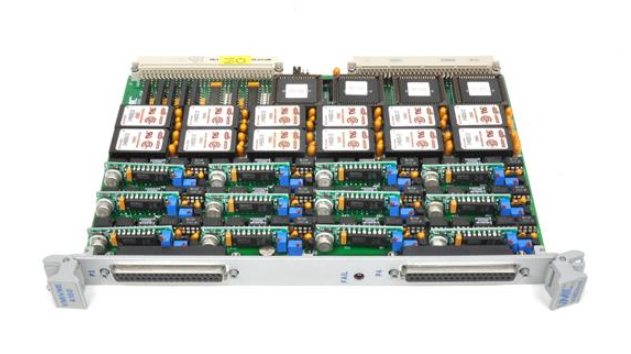The module has multiple independent analog output channels (the specific number of channels can be configured according to the model, commonly 8 or 16 channels), and each channel adopts high-precision D/A conversion chip, supporting 4-20mA current signal or 0-10V voltage signal output. Some models can be extended to support bipolar voltage output such as ± 5V and ± 10V. The D/A conversion accuracy can reach 16 bits, ensuring that the error of the output signal is controlled within an extremely low range, meeting the requirements of precision control scenarios, such as temperature control in chemical reaction vessels and motor speed regulation, which can effectively improve control accuracy.
GE VMIVME-4150 Analog Output Module
Core functions and advantages
1. Multi channel high-precision signal output
The module has multiple independent analog output channels (the specific number of channels can be configured according to the model, commonly 8 or 16 channels), and each channel adopts high-precision D/A conversion chip, supporting 4-20mA current signal or 0-10V voltage signal output. Some models can be extended to support bipolar voltage output such as ± 5V and ± 10V. The D/A conversion accuracy can reach 16 bits, ensuring that the error of the output signal is controlled within an extremely low range, meeting the requirements of precision control scenarios, such as temperature control in chemical reaction vessels and motor speed regulation, which can effectively improve control accuracy.
2. Flexible configuration and control methods
Supports the VME64 bus specification and can be seamlessly integrated into control systems based on the VME architecture to achieve high-speed data exchange with the host. The module provides two methods: hardware jumper and software configuration. Users can set the output type (current/voltage), range, signal filtering parameters, etc. of each channel through programming. At the same time, it supports channel independent enable/disable function, which facilitates personalized configuration for different load requirements. In addition, some models also have channel calibration function, which can eliminate signal drift after long-term use through software calibration and maintain output accuracy.
3. Powerful reliability and anti-interference ability
Adopting industrial grade hardware design, it supports a wide temperature working environment (usually -40 ℃~+85 ℃) and can adapt to harsh industrial site conditions. The module integrates overcurrent protection, overvoltage protection, and short-circuit protection circuits. When an abnormal load occurs at the output terminal, the signal output can be quickly cut off to avoid module damage and load equipment failure. At the same time, electrical isolation between the signal channel and the bus system is achieved through optoelectronic isolation technology, with an isolation voltage of up to 2500Vrms, effectively suppressing electromagnetic interference (EMI) and radio frequency interference (RFI) in industrial sites, and ensuring the stability of signal transmission.
4. Convenient status monitoring and diagnosis
The module is equipped with a comprehensive self diagnostic function, which can monitor key parameters such as D/A conversion circuit, power status, and channel load in real time, and provide diagnostic information feedback to the host system through the VME bus. In addition, the front of the module is designed with status indicator lights, including power indicator lights, module ready indicator lights, and output status indicator lights for each channel. Users can quickly determine the working status of the module through the indicator lights, which is convenient for on-site troubleshooting and maintenance.
Key technical parameters
Bus standard
VME64, Compatible with VMEbus 1.4 specification
Number of output channels
8 channels/16 channels (optional)
Output signal type
Current: 4-20mA; Voltage: 0-10V, ± 5V, ± 10V (optional)
D/A conversion accuracy
16 bits
linear error
± 0.01% full scale (FSR)
temperature drift
± 5ppm/℃ (typical value)
response time
≤ 10 μ s (from digital command to stable signal output)
isolation performance
Isolation between channel and bus, isolation voltage 2500Vrms
Power requirements
+5V DC, ± 12V DC, or ± 15V DC (depending on the model)
Working temperature range
-40℃ ~ +85℃
Mechanical dimensions
Compliant with VME standard size, 3U or 6U board (optional)
Applicable scenarios
1. Industrial automation control: used in PLC and DCS systems to output control signals to actuators such as frequency converters, regulating valves, servo motors, etc., to achieve precise adjustment of parameters such as temperature, pressure, flow rate, and liquid level in the production process. It is widely used in industries such as petrochemicals, metallurgy, and power.
2. Aerospace and Defense: As a signal conversion interface in aviation electronic equipment and spacecraft control systems, it provides stable analog control signals for various sensors and actuators, meeting the requirements of high reliability and wide temperature environments.
3. Testing and measuring equipment: In automated testing systems, it is used to generate high-precision simulated excitation signals to test and calibrate the performance of the tested equipment, such as electronic component testing, medical device calibration, etc.
4. Transportation and energy system: In the rail transit signal system and smart grid monitoring system, signal interaction between the control system and on-site equipment is achieved to ensure the stable operation of the system.
Precautions for use
-When installing the module, it is necessary to strictly follow the VME bus specification to ensure good contact between the board and the bus slot, and to avoid communication failures or signal abnormalities caused by poor contact.
-Before wiring, it is necessary to confirm the power specifications and output signal types of the module. It is strictly prohibited to misconnect the power supply or confuse the signal lines to avoid damaging the internal circuits of the module.
-When used in industrial sites, modules should be installed in control cabinets with dust-proof, moisture-proof, and shockproof functions, and properly grounded to enhance anti-interference capabilities.
-When performing channel calibration or parameter configuration, it is necessary to disconnect the output load of the module first to avoid misoperation of the load device during the calibration process.
-When stored for a long time, the module should be placed in a dry, ventilated, and non corrosive gas environment, avoiding direct sunlight and high temperature and humidity environments to prevent component aging

- User name Member Level Quantity Specification Purchase Date
- Satisfaction :
-









Email:wang@kongjiangauto.com




































































































































